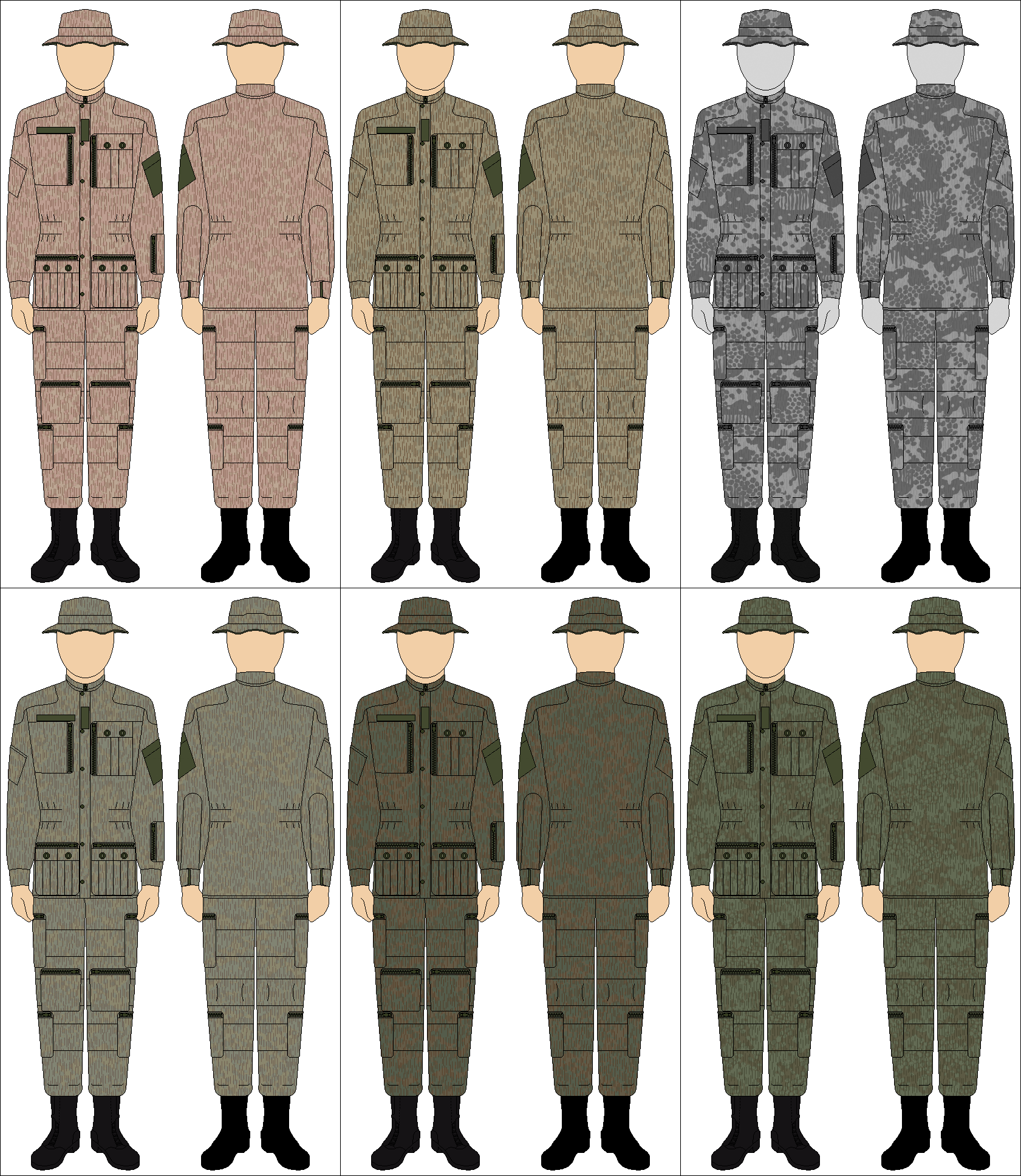ShopDreamUp AI ArtDreamUp
Deviation Actions
Suggested Deviants
Suggested Collections
You Might Like…
Featured in Groups
Description
The Czechoslovakian Vz60 Rain stripe was the Czechoslovakian take on the East German Rain stripe pattern. To begin with, the rain stripe over-pattern itself is larger than the German one. Another twist is the under-pattern. Normally the under-pattern has little contrast, so from a distance it has the same effect as the German pattern, but the pattern really comes to play when either wet or seen through infrared. The under-pattern is surprisingly disruptive, likely based on the Nazi-German SS-44 pea dot pattern.
The top color schemes are the ones that resemble the german patterns: Type 1 and Type 2 with the IR image.
Bottom color schemes show bias to woodland environments, one of which has enhanced contrast.
info dump:
================Kamouflage.net================
After World War 2, Czechoslovakia developed and issued no less than four distinct camouflage patterns that were based on the German wartime Sumpfmuster-43 (1943 marsh pattern) camouflage pattern. The first of these designs, used in the late 1940s and early 1950s for shelter halves, was virtually identical to some versions of the German pattern and was probably printed using original wartime rollers.
This 3-colour Sumpfmuster camouflage, produced in the mid-1960s to replace the very colourful mlok camouflage pattern, appeared in two distinct variant forms. In one, the dots and clumps are all but invisible. In the variant shown here, however, the dark green dots and clumps are very distinct and have grey-green borders. They are overprinted with a continuous pattern of grey-green dashes, and the background is a much lighter grey-green.
It seems likely that this Czechoslovakian 3-colour Sumpfmuster was the basis for the Bulgarian frogskin camouflage pattern.
================================================
================Camopedia================
The jehlicí (needles) or oblaky (clouds) pattern, was introduced into general service with the Czechoslovak Army in 1963 and saw service into the 1980s. Similar to other "rain" patterns employed by Warsaw Pact nations, the Czech version has brown rain straits on a greyish-blue background, with a subtle water-stain underprint beneath. Tint variations are documented, ranging from very light to very dark grey. Czech sources have indicated that the earlier productions of this pattern had much more pronounced appearance of the water-stain underprint; by later production this feature had almost disappeared. As can been seen on the examples below, the "clouds" feature can be quite subtle to the observer. A virtually unknown feature of the oblaky pattern is that it appears quite different when viewed through infared passive viewing system equipment, with the underprint coming out clearly and the pattern appearing as a completely different camouflage design. Seen below on the far right, is an image of the pattern through such PVS equipment in which the design changes dramatically, showing the "comb teeth" design as found in early leibermuster camouflage.
================================================
The top color schemes are the ones that resemble the german patterns: Type 1 and Type 2 with the IR image.
Bottom color schemes show bias to woodland environments, one of which has enhanced contrast.
info dump:
================Kamouflage.net================
After World War 2, Czechoslovakia developed and issued no less than four distinct camouflage patterns that were based on the German wartime Sumpfmuster-43 (1943 marsh pattern) camouflage pattern. The first of these designs, used in the late 1940s and early 1950s for shelter halves, was virtually identical to some versions of the German pattern and was probably printed using original wartime rollers.
This 3-colour Sumpfmuster camouflage, produced in the mid-1960s to replace the very colourful mlok camouflage pattern, appeared in two distinct variant forms. In one, the dots and clumps are all but invisible. In the variant shown here, however, the dark green dots and clumps are very distinct and have grey-green borders. They are overprinted with a continuous pattern of grey-green dashes, and the background is a much lighter grey-green.
It seems likely that this Czechoslovakian 3-colour Sumpfmuster was the basis for the Bulgarian frogskin camouflage pattern.
================================================
================Camopedia================
The jehlicí (needles) or oblaky (clouds) pattern, was introduced into general service with the Czechoslovak Army in 1963 and saw service into the 1980s. Similar to other "rain" patterns employed by Warsaw Pact nations, the Czech version has brown rain straits on a greyish-blue background, with a subtle water-stain underprint beneath. Tint variations are documented, ranging from very light to very dark grey. Czech sources have indicated that the earlier productions of this pattern had much more pronounced appearance of the water-stain underprint; by later production this feature had almost disappeared. As can been seen on the examples below, the "clouds" feature can be quite subtle to the observer. A virtually unknown feature of the oblaky pattern is that it appears quite different when viewed through infared passive viewing system equipment, with the underprint coming out clearly and the pattern appearing as a completely different camouflage design. Seen below on the far right, is an image of the pattern through such PVS equipment in which the design changes dramatically, showing the "comb teeth" design as found in early leibermuster camouflage.
================================================
Image size
1681x1937px 1.55 MB
Comments8
Join the community to add your comment. Already a deviant? Log In
very good work










![[SLOV/ISDA] Teaser #1 - German Uniform Comparison](https://images-wixmp-ed30a86b8c4ca887773594c2.wixmp.com/f/4aa98014-f2f5-472b-8889-a3933327d3c1/dexi77x-24e08cd3-a72d-4f25-95ea-bbf137f95407.png/v1/crop/w_92,h_92,x_0,y_28,scl_0.098395721925134/_slov_isda__teaser__1___german_uniform_comparison_by_etccommand_dexi77x-92s.png?token=eyJ0eXAiOiJKV1QiLCJhbGciOiJIUzI1NiJ9.eyJzdWIiOiJ1cm46YXBwOjdlMGQxODg5ODIyNjQzNzNhNWYwZDQxNWVhMGQyNmUwIiwiaXNzIjoidXJuOmFwcDo3ZTBkMTg4OTgyMjY0MzczYTVmMGQ0MTVlYTBkMjZlMCIsIm9iaiI6W1t7ImhlaWdodCI6Ijw9MjA3NyIsInBhdGgiOiJcL2ZcLzRhYTk4MDE0LWYyZjUtNDcyYi04ODg5LWEzOTMzMzI3ZDNjMVwvZGV4aTc3eC0yNGUwOGNkMy1hNzJkLTRmMjUtOTVlYS1iYmYxMzdmOTU0MDcucG5nIiwid2lkdGgiOiI8PTkzNSJ9XV0sImF1ZCI6WyJ1cm46c2VydmljZTppbWFnZS5vcGVyYXRpb25zIl19.3JEx57gtF1W7QWNuz0uIxFaVd7Oc0UFfdDmsTIhA__o)
![[TALA] Alternate Bundeswehr Orders of Dress M1993](https://images-wixmp-ed30a86b8c4ca887773594c2.wixmp.com/f/4aa98014-f2f5-472b-8889-a3933327d3c1/ddt7x2o-7cc824f2-25de-46ae-8061-43fb9fc709ce.png/v1/crop/w_92,h_92,x_7,y_0,scl_0.043539990534785,q_70,strp/_tala__alternate_bundeswehr_orders_of_dress_m1993_by_etccommand_ddt7x2o-92s.jpg?token=eyJ0eXAiOiJKV1QiLCJhbGciOiJIUzI1NiJ9.eyJzdWIiOiJ1cm46YXBwOjdlMGQxODg5ODIyNjQzNzNhNWYwZDQxNWVhMGQyNmUwIiwiaXNzIjoidXJuOmFwcDo3ZTBkMTg4OTgyMjY0MzczYTVmMGQ0MTVlYTBkMjZlMCIsIm9iaiI6W1t7ImhlaWdodCI6Ijw9MjExMyIsInBhdGgiOiJcL2ZcLzRhYTk4MDE0LWYyZjUtNDcyYi04ODg5LWEzOTMzMzI3ZDNjMVwvZGR0N3gyby03Y2M4MjRmMi0yNWRlLTQ2YWUtODA2MS00M2ZiOWZjNzA5Y2UucG5nIiwid2lkdGgiOiI8PTI3NTAifV1dLCJhdWQiOlsidXJuOnNlcnZpY2U6aW1hZ2Uub3BlcmF0aW9ucyJdfQ.UcEU37u7LSy41SEnl3oCqrwAEuuFPA9de9eatekMYyE)
![[TALA] US Army Infantry Uniform Regulations (AU)](https://images-wixmp-ed30a86b8c4ca887773594c2.wixmp.com/f/4aa98014-f2f5-472b-8889-a3933327d3c1/dehs5zz-725ba3af-03c0-4735-8a7f-7f2195e7b292.png/v1/crop/w_92,h_92,x_29,y_0,scl_0.044294655753491/_tala__us_army_infantry_uniform_regulations__au__by_etccommand_dehs5zz-92s.png?token=eyJ0eXAiOiJKV1QiLCJhbGciOiJIUzI1NiJ9.eyJzdWIiOiJ1cm46YXBwOjdlMGQxODg5ODIyNjQzNzNhNWYwZDQxNWVhMGQyNmUwIiwiaXNzIjoidXJuOmFwcDo3ZTBkMTg4OTgyMjY0MzczYTVmMGQ0MTVlYTBkMjZlMCIsIm9iaiI6W1t7ImhlaWdodCI6Ijw9MjA3NyIsInBhdGgiOiJcL2ZcLzRhYTk4MDE0LWYyZjUtNDcyYi04ODg5LWEzOTMzMzI3ZDNjMVwvZGVoczV6ei03MjViYTNhZi0wM2MwLTQ3MzUtOGE3Zi03ZjIxOTVlN2IyOTIucG5nIiwid2lkdGgiOiI8PTQ3MTQifV1dLCJhdWQiOlsidXJuOnNlcnZpY2U6aW1hZ2Uub3BlcmF0aW9ucyJdfQ.upOw6ltb-B3CfPuVP1Uqs9h9XaILopTRlXnYaTL6gAE)





![[Alt Hist] Grand Emperor Xhi Chien](https://images-wixmp-ed30a86b8c4ca887773594c2.wixmp.com/f/53092978-bc2d-4ecb-9894-07012672db29/d8mwtsi-178b4edc-a0a3-45dd-a3fc-8679b7b43c7f.png/v1/crop/w_92,h_92,x_3,y_0,scl_0.094358974358974,q_70,strp/_alt_hist__grand_emperor_xhi_chien_by_luke27262_d8mwtsi-92s.jpg?token=eyJ0eXAiOiJKV1QiLCJhbGciOiJIUzI1NiJ9.eyJzdWIiOiJ1cm46YXBwOjdlMGQxODg5ODIyNjQzNzNhNWYwZDQxNWVhMGQyNmUwIiwiaXNzIjoidXJuOmFwcDo3ZTBkMTg4OTgyMjY0MzczYTVmMGQ0MTVlYTBkMjZlMCIsIm9iaiI6W1t7ImhlaWdodCI6Ijw9OTc1IiwicGF0aCI6IlwvZlwvNTMwOTI5NzgtYmMyZC00ZWNiLTk4OTQtMDcwMTI2NzJkYjI5XC9kOG13dHNpLTE3OGI0ZWRjLWEwYTMtNDVkZC1hM2ZjLTg2NzliN2I0M2M3Zi5wbmciLCJ3aWR0aCI6Ijw9MTA5NCJ9XV0sImF1ZCI6WyJ1cm46c2VydmljZTppbWFnZS5vcGVyYXRpb25zIl19.shCqS2e3V-sLxYWw12kkqp2fywbSgRHwXNMKX-QmYzg)
![[TALA] Alternate Bundeswehr Orders of Dress M1993](https://images-wixmp-ed30a86b8c4ca887773594c2.wixmp.com/f/4aa98014-f2f5-472b-8889-a3933327d3c1/ddt7x2o-7cc824f2-25de-46ae-8061-43fb9fc709ce.png/v1/crop/w_184)




![[U.S. Army] Mess Blues](https://images-wixmp-ed30a86b8c4ca887773594c2.wixmp.com/f/5f52c2fb-2946-49c9-a35c-c99c73db26a6/ddpgpm1-97dfb71f-5e85-4c0d-8112-1125b1e73d09.png/v1/crop/w_184)




![American Commonwealth BDU 1986 [5 Different]](https://images-wixmp-ed30a86b8c4ca887773594c2.wixmp.com/f/befadc8a-4179-4c0d-b75e-67b312b598ad/d6xea9t-6ac9f7f9-f3a7-487b-8fe1-626ca79d36b7.png/v1/crop/w_184)





